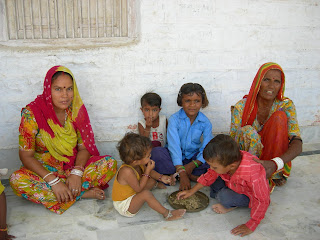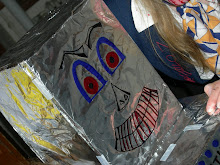Monday night I witnessed my first desert sandstorm. I was just finishing up taking an online survey in a cybercafe around 6:30 when all of a sudden the sky turned orange and then pitch black. The wind immediately picked up and all the power shut off. The owners of the place shut and latched the windows and doors and scrambled to find candles. We waited for about half an hour in darkness listening to the banging outside. After the worst was over we opened the door and just watched the rain and wind blow for awhile. I had to walk about 10 minutes to get home and got poured on. We didn't get power back for 16 hours. My host mother, host sister, and Deva spent all day yesterday scrubbing the house and washing off the dust that blew in. The villagers we visited yesterday said that their clothes and food all blew away. All over town billboards and power lines were blown down and destroyed. And then last night it happened again!!! Only this time we were more prepared and shut the windows really quick and the power was only out for about 10 minutes. At least after the storms the temperature drops nicely.
Monday and Tuesday I went with Nazima and the two interns to the village of Kaperda. They have 4 anganwadis, so we did a lot of visiting and weighing. Yesterday I guess I gave the pot of rice mixture they serve the children too long of a look and before I knew it I had a plate in front of me. it seemed really wrong for me to be eating unicef donations but the workers were determined that I should try it. It wasn't bad--sort of like flavorless porridge. I felt so fat and spoiled.
Yesterday I was starting to get a little frustrated with my working situation because for the ninth day I was still just following these other interns around as they spoke hindi to the villagers and to each other. At the end of the day I had a meeting with the FSD staff and my organization head honchos and we talked about what I will be doing for the rest of the summer. I will continue doing the nutritional surveys in villages, but on my own with a translator. The point of the surveys is to come up with some nutritional data to put in a grant proposal for Unicef which I will present to Unicef's regional officer at the end of the summer. The more they talked about it, the bigger the project seemed to get. I'm kind of nervous, but I'm excited to be doing something concrete.
I don't know why, but it seems like everyone can say no to more food but me. When Indian women periodically go around the circle of people eating and try to force more food onto everyone's plates, I feel like I put up a pretty good fight. I say "No! No! Bas! Bas! (enough!)" and try to cover my plate up and then resort to "Later! I'll eat more later!!" but I am almost never successful at convincing them. Then the ladies continue around and if any other (Indian) person says no, they press for a second and then relent. I wish I could convey to them that I'm just trying to avoid heart disease. Also, I think that Ladyfingers are okra. I have just never seen fresh okra before. I will continue to investigate. For breakfast this morning I had fresh mango, a lassi, and three parathas. Three because this time I was actually hungry, but I think I would have ended up eating three whether I wanted to or not. For our other meals we've kind of gone into disaster mode thanks to the storm, so we have been eating winter food. Last night Anitaji made this sort of porridgey stuff that was dried chapati mixed with a soupy, spicy, vegetabley broth/gravy and then we also had mangos with cream. Delicious!! But it was my fourth or fifth meal of the day so I tried to take it easy.
I've been trying to wake up earlier in the mornings to enjoy the cool breezes that disappear after about 7;30 am, and it has given me the opportunity to enjoy new varieties of Old Indian Man outfits. They frequently putter about the house, yard, or terrace in an undershirt and a little wrapped skirt. Sometimes men fold the skirt into shorts, sometimes the skirt is a colorful towel, and sometimes it is just a skirt. On the other end, little Indian boys like to wear their shirts tucked in around their armpits with their little shorts or pants tightly cinched. It's pretty endearing.
On Sunday some men came by the house and after an elaborate sequence of weighing, sorting, indignant shouting and bargaining, my host mother sold all of the recycling for 130 Rs., or enough to buy vegetables for the day. I was intrigued. I told them, in the great land of America, we have to pay people to take away our garbage and recycling. In India, people come to you and then pay you for it?! Awesome. On the other hand, I do like our system b/c people use it. I'm not sure many people in India bother to do anything with their garbage besides throw it to the neighborhood goat herd. I saw a cow chewing on a plastic bag the other day, and that was sad.
I love that adventure is in the air everywhere in India. Just walking on the sidewalks you take your life in your hands; navigating through a roundabout is only for the foolish, or those under 25. My favorite necessary yet incredibly dangerous activity is taking public transit about town. I find autorickshaws a little overwhelming, and they are usually 10 times more expensive and slower than busing. The buses are absolutely reckless. They stop for no one except the cows, weave in and out of scooters and bicycles, stop and accelerate suddenly, and I don't think a single bus was built less than 35 years ago. My favorite driver/conducter combo commands the Number 4 bus heading Southwest around 6 or 7. The ride always takes under 10 minutes and it is 5 Rs. of pure thrills.
Coming up on 3 weeks of India! It's my new absolutely favorite country. Sorry, Iceland.
Lots of stuff
15 years ago









